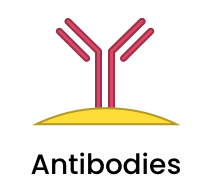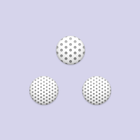- Introduction to gene and cell therapy enabling properties of nanoparticles
- Nanoparticle selection guidelines
- Examples of cell and gene therapy applications
Cell & Gene Therapy Enabling Properties of Nanoparticles
 Cell and gene therapy is a rapidly advancing field that aims to treat genetic disorders and severe diseases by modifying or replacing malfunctioning cells and genes. Cell therapy involves transplanting live, functional cells to repair or replace damaged tissue, while gene therapy modifies or manipulates a patient's genetic material. Nanomaterials, engineered at the nanoscale, enhance these therapies by serving as efficient delivery vehicles, protecting genetic material, and enabling controlled release of therapeutic agents. Their unique properties are crucial in advancing the precision and efficacy of these treatments, offering new hope for combating complex diseases.
Cell and gene therapy is a rapidly advancing field that aims to treat genetic disorders and severe diseases by modifying or replacing malfunctioning cells and genes. Cell therapy involves transplanting live, functional cells to repair or replace damaged tissue, while gene therapy modifies or manipulates a patient's genetic material. Nanomaterials, engineered at the nanoscale, enhance these therapies by serving as efficient delivery vehicles, protecting genetic material, and enabling controlled release of therapeutic agents. Their unique properties are crucial in advancing the precision and efficacy of these treatments, offering new hope for combating complex diseases.
The integration of tailored nanoparticles with modified surface functionalization can be used to address the challenges associated with nucleic acid stability and retention, targeted delivery, and transport across biological barriers that are common to gene therapy. Nanoparticle quality by design (QbD) considerations for this end application include:
- What dosage and how many applications will be administered during treatment?
- What are the desired drug release kinetics?
- Will the nanoparticles accumulate in the body or what is the clearance pathway?
Recently the field of cell therapy has benefited from the use of 3D scaffolds to provide harvested cells with a biocompatible platform which fosters improved metabolic exchange and multicellular interactions in the presence of cytokines, growth factors, extracellular matrix components, etc. The integration of tailored nanoparticles enhances the effectiveness of these 3D scaffolds by providing additional topographical, biochemical, and mechanical cues for improved cellular organization and functionality.
Nanoparticle quality by design (QbD) considerations for designing these scaffolds include:
- What nanoparticle material, shape, and spatial density is required for sufficient cell growth?
- What cellular cues need to be incorporated onto the nanoparticle scaffold?
The ability to tailor the nanoparticle composition, size, shape, and surface functionalization allows a tailored approach to addressing concerns around the nanomedicine’s biodistribution, release, and clearance profiles in gene therapy or the nanoparticle scaffold cell therapy applications.
References
- Mendes, B.B., Conniot, J., Avital, A. et al. Nanodelivery of nucleic acids. Nat Rev Methods Primers 2, 24 (2022).
- El-Kadiry, Abed El-Hakim, Moutih Rafei, and Riam Shammaa. "Cell therapy: types, regulation, and clinical benefits." Frontiers in Medicine 8 (2021): 756029.
- Dickinson, Laura E., and Sharon Gerecht. "Engineered biopolymeric scaffolds for chronic wound healing." Frontiers in physiology 7 (2016): 213166.
- Hollister, Scott J. "Porous scaffold design for tissue engineering." Nature materials 4.7 (2005): 518-524.
Nanoparticle Selection Guidelines
The selection of nanoparticle type and surface chemistry for cell and gene therapy applications depends on a variety of factors, such as chemical properties of the payload, payload release kinetics, nanoparticle stability, and nanoparticle surface modifications/roughness cues.
Nanoparticle Material and Morphology
| Nanoparticle Type | Key Properties | Uses in Gene Therapy Applications | Uses in Cell Therapy Applications |
|---|---|---|---|
|
Solid silica nanoparticles
|
-Biocompatible -Controllable size, shape, morphology -Pores in MSN can be selectively modified -High loading capacity |
- Electrostatically bind genetic material to particle surface or within pores - Enable targeted delivery to specific cells |
-Can be incorporated into scaffolds for small molecule drug loading and release |
|
Mesoporous silica nanoparticles (MSN) |
-Biocompatible -Controllable size, shape, pore size and morphology -Pores in MSN can be selectively modified -High loading capacity |
- Can deliver a wide range of nucleic acids, from small microRNA (miRNA) to large plasmid DNA (pDNA) - Enable targeted delivery to specific cells - Up to 30 wt% loading of small molecules into MSN - Up to 10 wt% loading of messenger RNA (mRNA) into large pore MSN |
-Provides a multi-functional scaffold capable of drug-loading and promoting cell binding |
|
Gold Nanoparticles |
-Unique optical properties -Versatile surface chemistry -Controllable size, shape, morphology -Inert chemical properties -Biocompatible |
-Ultrasmall nanoparticles are able to penetrate nuclear envelope and efficiently deliver siRNA -Ready surface conjugation for payload or targeting ligands
|
-When patterned on solid substrates, can act as ex vivo cellular anchoring sites
|
|
Silver Nanoparticles |
-Unique optical properties -Versatile surface chemistry -Controllable size, shape, morphology
|
-Not generally utilized in gene therapy applications, though may be useful for antibacterial properties |
-Provide antibacterial and antiplatelet properties |
|
Iron Oxide Nanoparticles |
-Controllable size, shape, morphology -Controllable via magnetic response |
-Ultrasmall nanoparticles are able to penetrate nuclear envelope and efficiently deliver siRNA -Multifunctional for theranostic applications |
-When patterned on solid substrates, can act as ex vivo cellular anchoring sites |
|
Polymer and Lipid Nanoparticles |
-Biocompatible -Biodegradable -High loading capacity |
-Encapsulates nucleic acids and protects from degradation -Typical loading of genetic material around 10% |
-Often used as backbone of larger 3D scaffolds
|
Nanoparticle Surface Modification
Implementing nanoparticles for drug delivery applications requires the selection of not only the appropriate particle size, shape, and material type but also the appropriate surface chemistry and targeting ligands. At nanoComposix, we can modify the surface of many nanoparticles with specific functional groups, biocompatible polymers, and biomolecules (proteins, antibodies, oligonucleotides). The table below summarizes some of the most common surface modifications employed by nanoComposix for drug delivery applications.
| Modification | Description |
|---|---|
 |
Genetic materials such as DNA, RNA, hairpin structures, and oligonucleotides (oligos) can be passively or covalently attached to a nanoparticle surface or encapsulated. |
 |
Lipid coatings enable greater nanoparticle biocompatibility and may extend circulation half-life. These biomimetic coatings may also help to protect sensitive payloads such as genetic material. |
 |
Polyethylene glycol (PEG) ligands offer a high degree of biocompatibility, can improve stability in high salt environments, and reduce non-specific interactions. PEG ligands can be covalently bound to the metal surface to produce stable coatings. In addition, certain bi-functional PEGs can be employed to introduce other surface functionalization. |
 |
Antibodies (Ab), including fragments and VHH single domain antibodies can be conjugated onto a variety of nanoparticles using standard EDC/NHS chemistry or via a host of bioorthogonal click chemistry methods, depending on the particle type. |
 |
Proteins are able to be conjugated onto a nanoparticle surface using the same type of conjugation chemistry used for Ab. If more than one protein per nanoparticle needs to be conjugated onto a nanoparticle, this can be accomplished using bioorthogonal click chemistry. |
 |
Sometimes only a short fragment is needed to direct the nanomedicine to the correct target, and can be accomplished by conjugating specific peptide sequences to the nanoparticle surface. |
 |
Various fluorophores can be covalently attached or may be encapsulated within the nanoparticle. |
For other RUO nanomedicine applications, visit our drug delivery and photothermal therapy pages.
Examples of Nanoparticle Use in Cell and Gene Therapy Applications
Cell Therapy
- Goreham, Renee V., et al. "Small surface nanotopography encourages fibroblast and osteoblast cell adhesion." Rsc Advances 3.26 (2013): 10309-10317.
- Li, Pinggui, et al. "Tuning neuron adhesion and neurite guiding using functionalized AuNPs and backfill chemistry." Rsc Advances 5.49 (2015): 39252-39262.
- Alon, N., Miroshnikov, Y., Perkas, N., Nissan, I., Gedanken, A., & Shefi, O. (2014). Substrates coated with silver nanoparticles as a neuronal regenerative material. International Journal of Nanomedicine, 9(sup1), 23–31.
- Agrawal, Harshal, and Erik C. Garnett. "Nanocube imprint lithography." ACS nano 14.9 (2020): 11009-11016.
- Sobral, Miguel. Developing strategies to enhance immune responses induced by mesoporous silica rod vaccines. Diss. 2023.
- Xu, Chun, et al. "Mesoporous silica rods with cone shaped pores modulate inflammation and deliver BMP-2 for bone regeneration." Nano research 13 (2020): 2323-2331.
- Cheung, Alexander S., et al. "Scaffolds that mimic antigen-presenting cells enable ex vivo expansion of primary T cells." Nature biotechnology 36.2 (2018): 160-169.
- Baranes, Koby, et al. "Gold nanoparticle-decorated scaffolds promote neuronal differentiation and maturation." Nano letters 16.5 (2016): 2916-2920.
- Mahou, Redouan, et al. "Alginate-poly (ethylene glycol) hybrid microspheres for primary cell microencapsulation." Materials 7.1 (2014): 275-286.
Gene Therapy
- Chen, Jiajie, et al. "A coronavirus-mimic mesoporous silica nanosystem enables efficient targeted delivery of siRNA for anti-SARS-CoV‐2." Applied Materials Today 35 (2023): 101952.
- Huo, Shuaidong, et al. "Ultrasmall gold nanoparticles as carriers for nucleus-based gene therapy due to size-dependent nuclear entry." ACS nano 8.6 (2014): 5852-5862.
- Zhang, Huan, et al. "Nanoparticle cellular internalization is not required for RNA delivery to mature plant leaves." Nature nanotechnology 17.2 (2022): 197-205.
- Kamil Shareef, Noor Alhuda, Farshid Zandsalimi, and Gholamreza Tavoosidana. "Gold nanoparticles (AuNPs) decrease the viability of cervical cancer cells by inducing the BAX gene and activating antioxidant enzymes." Molecular Biology Reports 51.1 (2024): 287.
- Zhang, Jinsong, Tianyuan Zhang, and Jianqing Gao. "Biocompatible iron oxide nanoparticles for targeted cancer gene therapy: A review." Nanomaterials 12.19 (2022): 3323.
- Figueroa, Elizabeth R., et al. "Optimization of PAMAM-gold nanoparticle conjugation for gene therapy." Biomaterials 35.5 (2014): 1725-1734.
- López-Cerdá, Sandra, et al. "Study of the Synergistic Immunomodulatory and Antifibrotic Effects of Dual-Loaded Budesonide and Serpine1 siRNA Lipid–Polymer Nanoparticles Targeting Macrophage Dysregulation in Tendinopathy." ACS Applied Materials & Interfaces (2024).
- Choi, John, et al. "Nonviral polymeric nanoparticles for gene therapy in pediatric CNS malignancies." Nanomedicine: Nanotechnology, Biology and Medicine 23 (2020): 102115.
- Apaolaza, Paola Stephanie, et al. "A novel gene therapy vector based on hyaluronic acid and solid lipid nanoparticles for ocular diseases." International journal of pharmaceutics 465.1-2 (2014): 413-426.




